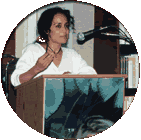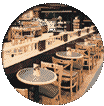
|
|
|
As the world's largest bookseller, the principal theme Barnes and Noble signifies is that of a bookstore. However, as a space, Barnes and Noble is much more than just a bookstore. It has grown to serve as an educational space in which one can actually "buy" knowledge; as a recreational space through the café area where customers can sit down, relax, and start to read their purchases while enjoying a muffin and cup of coffee; and as a popular culture space in which Barnes and Noble captures issues, concerns, and celebrities in contemporary society through their merchandise (books, magazines, music, and other media). As stated in their mission statement, Barnes and Noble is to be a valuable resource to their customers, bringing books and ideas to the American public. In the mission, Barnes and Noble explains how we live in a diverse culture, and that diversity is reflected in the wide range of interests, philosophies, and lifestyles of their customers. Therefore, Barnes and Noble provides an extensive selection of books, allowing the customer what to buy and what to read.
Barnes and Noble stores are virtually everywhere in which
potential customers might be found. One can shop at this
major bookseller in malls, in universities and colleges, in
private independent stores off of highways, in airports and
now online. As seen in all of these locations, Barnes and
Noble appears to be quite accessible however, with a closer
look, it is accessible to only a certain group of people.
For most of the locations listed above, except for in malls
in which public transportation may be provided, customers
need their own transportation. To take part in online
business, customers must have a computer and furthermore be
computer literate. Although now computers are in most public
libraries, online purchases often require a credit card.
Even in the college bookstores one finds a certain kind of
people. These certain kinds of people, the potential
customers of Barnes and Noble, are literate, have the desire
to have a library of their own at home, want to be "up" on
the newest authors, and need to have some money in which
they can buy Barnes and Noble products. Barnes and Noble,
like most shopping enterprises, does not sell essentials to
life and survival. So most people who shop at and purchase
from Barnes and Noble are investing in a luxury. This is
true of shopping in general, it is accessible to a certain
group of people who can afford to buy more than just the
essentials. Because Barnes and Noble is a specific kind of
shopping, this "certain kind of people" is even more
limited.
However, Barnes and Noble does an incredible job to ensure
that within this certain kind of people, every person's
needs and interests can be met. This bookseller offers books
or magazines on any and all subjects. In addition, there is
also a wide Spanish selection to meet the needs of our
changing society. Music and computer media are also
available. Furthermore, the selection at each Barnes and
Noble reflects the interests of the local community it
serves therefore increasing the consumption rate. Also, the
increasing consumption rate is the discount Barnes and Noble
offers to their customers in who receive 30% off hardcover
bestsellers, 30% off trade and mass market paperback
bestsellers, and 20% off Special Featured Titles. Barnes and
Noble increases participation rate by providing reviews,
recommendations from editors, Top 10 lists, etc. The major
bookseller also reaches its customers by sending out
personal e-mail notifying them about books, subject areas
and authors of personal interest. These customers also have
access to excerpts, sample chapters and reader reviews.
Through many different types of merchandise and the wide
variety that is offered within each merchandise selection,
Barnes and Noble appeals to all ages. It is important to
remember that although Barnes and Noble has proven to be
widely accessible and appealing, it is only a certain group
of people that can afford this luxury.
Barnes and Noble once again goes beyond that of a major
bookseller by investing in their communities. The bookseller
has been known to host craft nights, poetry readings, and
children's events. One can also take hundreds of free online
courses in a variety of subjects promoting Barnes and Noble
"continuing education" mission. Customers, although not
physically buying any merchandise, are on the Barnes and
Noble website, therefore participating in the brand. In
addition, as seen in Greenfield, Wisconsin, Barnes and Noble
paired up with local high school English teachers to provide
a casual environment for students to study and review books
on the AP English test and parts of the ACT test. This was
not done without any reward however. Students who attended
these review sessions (once again only a certain type of
student is in an AP English class) received a voucher and
extra credit in his/her class. Barnes and Noble got press
coverage for their support of education in our communities.
Also supporting literacy, in Dallas, Texas, Barnes and Noble
sponsored the Drop Everything and Read program promoting
literacy. Barnes and Noble paid celebrities to come in to
the schools and read to the students. Concerned with
reducing and preventing the development of prejudiced
attitudes in young children, Barnes and Noble started the
Close the Book on Hate campaign offering free education
events for all community members at Barnes and Noble Stores
and published the brochure Close the Book on Hate: 101 Ways
to Combat Prejudice. It is important to note that in the
back of this brochure is the Close the Book on Hate reading
list (selected titles community members are urged to read)
in which the name of the book, author, and price is given.
All of these books are available at Barnes and Noble stores.
As seen in many of these instances, while helping the
community, Barnes and Noble is also making money. In some
communities such as college campuses, every member is a
potential customer. When Barnes and Noble takes over college
bookstores, they know that students have to buy books each
semester. Furthermore, they can charge it right on to their
parents account. The bookseller provides them with the books
they need, right on campus, with no competition ensuring
their profits and success.
As a physical space, developers and designers have created
the "classic" bookstore; a place where lovers of books and
magazines can browse the shelves for hours, finding
everything from their favorite Shakespeare play to the #1
New York Times bestseller. Customers shop in this physical
space filled with couches, a café, and light music
playing in the background. Barnes and Noble symbolizes a
space in which people can get out of their hectic routine
and are encouraged to take a break and curl up with a book.
They are making money by appealing to people's inner desires
and hobbies that we don't always make time for. It also
symbolizes a place for sharing of ideas and knowledge.
Barnes and Noble makes money by portraying themselves as
philanthropists, gaining the money of others for a good
cause. As a physical themed space, Barnes and Noble has
control over its environment and the experience of it.
Barnes and Noble is accessible and appealing, however the
use values and sign values enabling profit are directed at a
specific type of customer who has the desire and money to
purchase their merchandise.



